Deck 19: Africa Before 1800
Question
Question
Question
Question
Question
Question
Question
Question
Question
Question
Question
Question
Question
Question
Question
Question
Question
Question
Question
Question
Question
Question
Question
Question
Question
Question
Question
Question
Question
Question
Question
Question
Question
Question
Question
Question
Question
Question
Question
Question
Question
Question
Question
Question
Question
Question
Question
Question
Question
Question

Unlock Deck
Sign up to unlock the cards in this deck!
Unlock Deck
Unlock Deck
1/50
Play
Full screen (f)
Deck 19: Africa Before 1800
1
The Ife figures from the Yoruba kingdom were used mainly in which rituals?
A) Funereal rites
B) Initiations
C) Birth rituals
D) Sacred kingship
A) Funereal rites
B) Initiations
C) Birth rituals
D) Sacred kingship
D
2
In which group are women the principal creators of ceramics and clay sculpture?
A) Sapi
B) Benin
C) Nok
D) Igbo-Ukwu
A) Sapi
B) Benin
C) Nok
D) Igbo-Ukwu
C
3
Who are considered the regional ancestors of the Shona-speaking people?
A) The people of Benin
B) The people of Ife
C) The people of Lydenburg
D) The people of Great Zimbabwe
A) The people of Benin
B) The people of Ife
C) The people of Lydenburg
D) The people of Great Zimbabwe
D
4
In African art, scarification symbolizes which of the following?
A) Religious affiliation
B) Enslavement
C) Great age
D) Beauty and status
A) Religious affiliation
B) Enslavement
C) Great age
D) Beauty and status

Unlock Deck
Unlock for access to all 50 flashcards in this deck.
Unlock Deck
k this deck
5
The "horned headdress" of the running female from Tassili n'Ajjer is explained as which of the following?
A) Reference to male power
B) A mask
C) Ceremonial regalia
D) Signifies male and animal powers
A) Reference to male power
B) A mask
C) Ceremonial regalia
D) Signifies male and animal powers

Unlock Deck
Unlock for access to all 50 flashcards in this deck.
Unlock Deck
k this deck
6
Which of the following object types represents a unique hybrid of African and European cultures?
A) Benin whisks
B) Sapi ivories
C) Djenne figures
D) Ife jewelry
A) Benin whisks
B) Sapi ivories
C) Djenne figures
D) Ife jewelry

Unlock Deck
Unlock for access to all 50 flashcards in this deck.
Unlock Deck
k this deck
7
What system do the Benin use to record their history?
A) Bronze relief tablets
B) Complex oral recitations
C) Mounted wall plaques
D) Written documents
A) Bronze relief tablets
B) Complex oral recitations
C) Mounted wall plaques
D) Written documents

Unlock Deck
Unlock for access to all 50 flashcards in this deck.
Unlock Deck
k this deck
8
Tassili n'Ajjer is in which of the following countries?
A) Nigeria
B) Algeria
C) Sierra Leone
D) South Africa
A) Nigeria
B) Algeria
C) Sierra Leone
D) South Africa

Unlock Deck
Unlock for access to all 50 flashcards in this deck.
Unlock Deck
k this deck
9
Which of the following possessions would suggest the user holds a position of leadership?
A) Canoe
B) Feathered cloak
C) Silver spoon
D) Umbrella
A) Canoe
B) Feathered cloak
C) Silver spoon
D) Umbrella

Unlock Deck
Unlock for access to all 50 flashcards in this deck.
Unlock Deck
k this deck
10
Which of the following would most likely be used by the leader in order to magnify his gestures?
A) Mask
B) Fly whisk
C) Stool
D) Saltcellar
A) Mask
B) Fly whisk
C) Stool
D) Saltcellar

Unlock Deck
Unlock for access to all 50 flashcards in this deck.
Unlock Deck
k this deck
11
The inland floodplain of the Niger River has been likened to which of the following?
A) Rome
B) Mesopotamia
C) Constantinople
D) Teotihuacán
A) Rome
B) Mesopotamia
C) Constantinople
D) Teotihuacán

Unlock Deck
Unlock for access to all 50 flashcards in this deck.
Unlock Deck
k this deck
12
The artist called the Master of the Symbolic Execution has been identified as a master workshop artist from which culture?
A) Jenne
B) Sapi
C) Benin
D) Igbo-Ukwu
A) Jenne
B) Sapi
C) Benin
D) Igbo-Ukwu

Unlock Deck
Unlock for access to all 50 flashcards in this deck.
Unlock Deck
k this deck
13
Which of the following was a walled town circa 800 CE that had a diverse population with many specialist workshops?
A) Lagos
B) Great Zimbabwe
C) Jenne-Jeno
D) Djenne
A) Lagos
B) Great Zimbabwe
C) Jenne-Jeno
D) Djenne

Unlock Deck
Unlock for access to all 50 flashcards in this deck.
Unlock Deck
k this deck
14
The Great Zimbabwe enclosure is unusual in being made of which material?
A) Layered clay
B) Wood beams
C) Ashlar granite
D) Dry stone
A) Layered clay
B) Wood beams
C) Ashlar granite
D) Dry stone

Unlock Deck
Unlock for access to all 50 flashcards in this deck.
Unlock Deck
k this deck
15
Facial striping is an indicator in African societies for which type of individual?
A) A thief
B) A scorned woman
C) Titled person
D) The priest
A) A thief
B) A scorned woman
C) Titled person
D) The priest

Unlock Deck
Unlock for access to all 50 flashcards in this deck.
Unlock Deck
k this deck
16
Which of the following is a characteristic of the Nok style in ceramic sculpture?
A) Inverted pot shape
B) Scarification
C) Double chevron motif
D) Large eyes and heads
A) Inverted pot shape
B) Scarification
C) Double chevron motif
D) Large eyes and heads

Unlock Deck
Unlock for access to all 50 flashcards in this deck.
Unlock Deck
k this deck
17
The figural art of which culture is realistic but at the same time idealized?
A) Igbo-Ukwu
B) Ife
C) Sapi
D) Benin
A) Igbo-Ukwu
B) Ife
C) Sapi
D) Benin

Unlock Deck
Unlock for access to all 50 flashcards in this deck.
Unlock Deck
k this deck
18
What objects did Sapi artists create for export during the 16th century?
A) Gold armlets
B) Ivory statuettes
C) Brass altars
D) Wooden masks
A) Gold armlets
B) Ivory statuettes
C) Brass altars
D) Wooden masks

Unlock Deck
Unlock for access to all 50 flashcards in this deck.
Unlock Deck
k this deck
19
The earliest African sculpture in the round was created by which of the following groups?
A) Ife
B) Benin
C) Sapi
D) Nok
A) Ife
B) Benin
C) Sapi
D) Nok

Unlock Deck
Unlock for access to all 50 flashcards in this deck.
Unlock Deck
k this deck
20
Where do Yoruba legends place the group's origins?
A) Benin City
B) Ife
C) Igbo-Ukwu
D) Tassili n'Ajjer
A) Benin City
B) Ife
C) Igbo-Ukwu
D) Tassili n'Ajjer

Unlock Deck
Unlock for access to all 50 flashcards in this deck.
Unlock Deck
k this deck
21
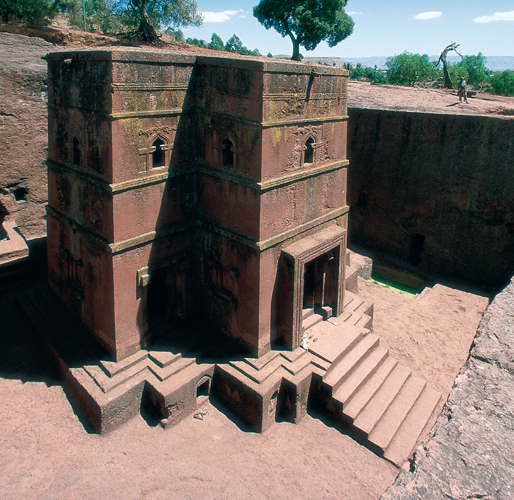
What modern country is the location of this rock-cut church?
A) Mali
B) Ethiopia
C) Nigeria
D) South Africa

What modern country is the location of this rock-cut church?
A) Mali
B) Ethiopia
C) Nigeria
D) South Africa

Unlock Deck
Unlock for access to all 50 flashcards in this deck.
Unlock Deck
k this deck
22
The fly-whisk hilt from Igbo-Ukwu is cast by which of the following means?
A) Clay
B) Hammered metal
C) Lost wax
D) Carved wood
A) Clay
B) Hammered metal
C) Lost wax
D) Carved wood

Unlock Deck
Unlock for access to all 50 flashcards in this deck.
Unlock Deck
k this deck
23
Which prestige object was excavated from a tomb in the Igbo-Ukwu area?
A) Crocodile leather
B) Monkey teeth
C) Elephant tusk
D) Lion skin
A) Crocodile leather
B) Monkey teeth
C) Elephant tusk
D) Lion skin

Unlock Deck
Unlock for access to all 50 flashcards in this deck.
Unlock Deck
k this deck
24
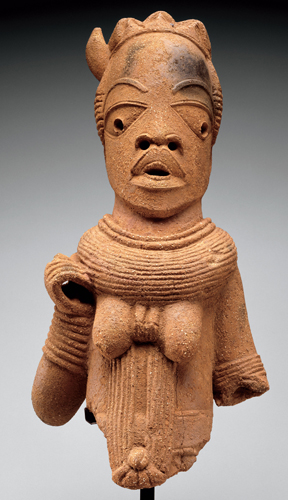
Which culture produced this figure of a woman?
A) Ife
B) Djenne
C) Benin
D) Nok

Which culture produced this figure of a woman?
A) Ife
B) Djenne
C) Benin
D) Nok

Unlock Deck
Unlock for access to all 50 flashcards in this deck.
Unlock Deck
k this deck
25
Which of the following European peoples established contact with the kingdom of Benin in the 1470s?
A) Spanish
B) Portuguese
C) British
D) French
A) Spanish
B) Portuguese
C) British
D) French

Unlock Deck
Unlock for access to all 50 flashcards in this deck.
Unlock Deck
k this deck
26
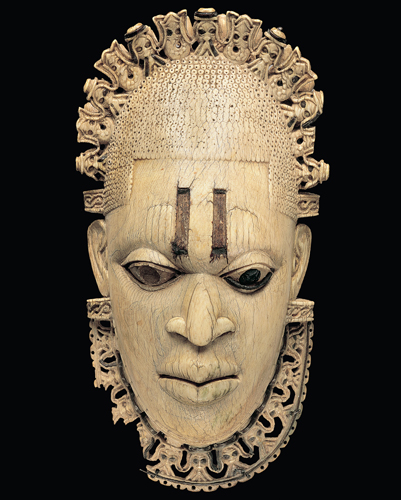
Who is the subject of this ivory figure?
A) Nature goddess
B) Masquerade participant
C) Queen mother
D) King Shyaam

Who is the subject of this ivory figure?
A) Nature goddess
B) Masquerade participant
C) Queen mother
D) King Shyaam

Unlock Deck
Unlock for access to all 50 flashcards in this deck.
Unlock Deck
k this deck
27
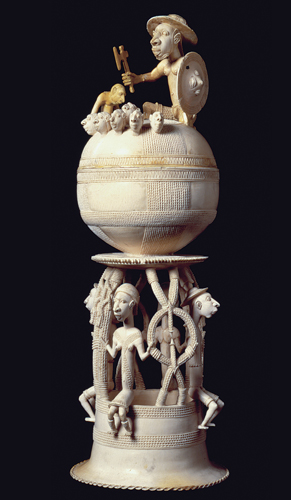
Who is the artist of this work?
A) Master of the Mudfish Heads
B) Benin Ivory Master
C) Master of the Symbolic Execution
D) Portuguese-Benin Sculptor

Who is the artist of this work?
A) Master of the Mudfish Heads
B) Benin Ivory Master
C) Master of the Symbolic Execution
D) Portuguese-Benin Sculptor

Unlock Deck
Unlock for access to all 50 flashcards in this deck.
Unlock Deck
k this deck
28
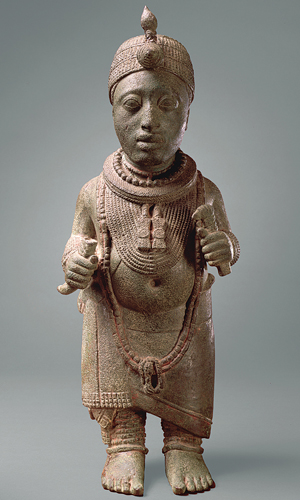
What material makes up this Ife ruler portrait?
A) Terracotta
B) Zinc-brass
C) Sandstone
D) Cotton thread

What material makes up this Ife ruler portrait?
A) Terracotta
B) Zinc-brass
C) Sandstone
D) Cotton thread

Unlock Deck
Unlock for access to all 50 flashcards in this deck.
Unlock Deck
k this deck
29
The earliest African sculpture in the round was produced by which group?
A) Ife
B) Djenne
C) Nok
D) Igbo-Ukwu
A) Ife
B) Djenne
C) Nok
D) Igbo-Ukwu

Unlock Deck
Unlock for access to all 50 flashcards in this deck.
Unlock Deck
k this deck
30
Which of the following facial features did the Sapi associate with African adornment and use as an identifier in their saltcellars?
A) Small round noses
B) Small almond-shaped eyes
C) Scarification
D) Narrow lips
A) Small round noses
B) Small almond-shaped eyes
C) Scarification
D) Narrow lips

Unlock Deck
Unlock for access to all 50 flashcards in this deck.
Unlock Deck
k this deck
31
Who or what does the mudfish symbolize in Benin iconography?
A) Trade and diplomatic relationships
B) The Benin people and ancestors
C) Dual human/divine aspect of the ruler
D) Sea-faring Portuguese traders
A) Trade and diplomatic relationships
B) The Benin people and ancestors
C) Dual human/divine aspect of the ruler
D) Sea-faring Portuguese traders

Unlock Deck
Unlock for access to all 50 flashcards in this deck.
Unlock Deck
k this deck
32
Recently, many Nok style works have left Nigeria through which of the following?
A) A government export program
B) A Benin export agreement
C) An illegal market
D) A United Nations-sanctioned market
A) A government export program
B) A Benin export agreement
C) An illegal market
D) A United Nations-sanctioned market

Unlock Deck
Unlock for access to all 50 flashcards in this deck.
Unlock Deck
k this deck
33
Which of the following best describe the composition of the Benin brass plaque?
A) Ascending, relative
B) Symmetrical, hierarchical
C) Asymmetrical, hierarchical
D) Equilateral, proportionate
A) Ascending, relative
B) Symmetrical, hierarchical
C) Asymmetrical, hierarchical
D) Equilateral, proportionate

Unlock Deck
Unlock for access to all 50 flashcards in this deck.
Unlock Deck
k this deck
34
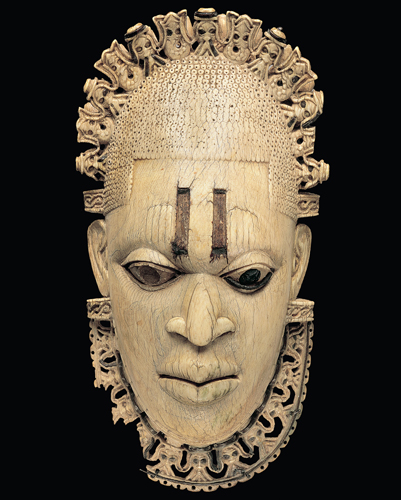
What is the material of this pendant of Queen Mother Idia?
A) Wood
B) Copper-bronze
C) Ceramic
D) Ivory

What is the material of this pendant of Queen Mother Idia?
A) Wood
B) Copper-bronze
C) Ceramic
D) Ivory

Unlock Deck
Unlock for access to all 50 flashcards in this deck.
Unlock Deck
k this deck
35
Which two animal figures appear on the soapstone monolith of Great Zimbabwe?
A) Horse and bird
B) Crocodile and bird
C) Turtle and crocodile
D) Turtle and elephant
A) Horse and bird
B) Crocodile and bird
C) Turtle and crocodile
D) Turtle and elephant

Unlock Deck
Unlock for access to all 50 flashcards in this deck.
Unlock Deck
k this deck
36
The presence of Portuguese heads on the Benin waist pendant of the queen mother indicates which of the following?
A) A victory of the Benin over the Portuguese
B) A marriage between the queen mother and a Portuguese lord
C) An item intended for export to Europe
D) An active diplomatic trade relationship
A) A victory of the Benin over the Portuguese
B) A marriage between the queen mother and a Portuguese lord
C) An item intended for export to Europe
D) An active diplomatic trade relationship

Unlock Deck
Unlock for access to all 50 flashcards in this deck.
Unlock Deck
k this deck
37
Large groups of ceramic sculpture dating between 1100 and 1500 CE have been excavated from an inland delta area in which modern country?
A) Niger
B) Zimbabwe
C) Namibia
D) Mali
A) Niger
B) Zimbabwe
C) Namibia
D) Mali

Unlock Deck
Unlock for access to all 50 flashcards in this deck.
Unlock Deck
k this deck
38

What is the date of the Lydenburg heads, as determined by radiocarbon testing?
A) 500 BCE
B) 1000 CE
C) 500 CE
D) 1000 BCE

What is the date of the Lydenburg heads, as determined by radiocarbon testing?
A) 500 BCE
B) 1000 CE
C) 500 CE
D) 1000 BCE

Unlock Deck
Unlock for access to all 50 flashcards in this deck.
Unlock Deck
k this deck
39
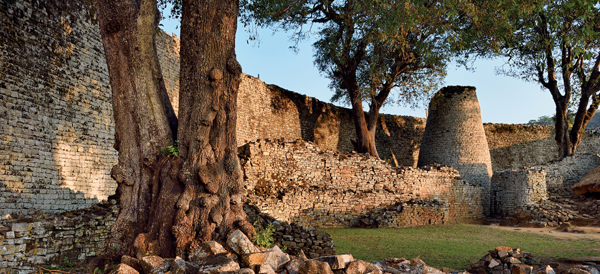
What is the date of the enclosure at Great Zimbabwe?
A) 17th century
B) 10th century
C) 6th century
D) 14th century

What is the date of the enclosure at Great Zimbabwe?
A) 17th century
B) 10th century
C) 6th century
D) 14th century

Unlock Deck
Unlock for access to all 50 flashcards in this deck.
Unlock Deck
k this deck
40
The rock art of Tassili n'Ajjer can be said to depict which of the following?
A) The god Olokun
B) Kings and queens
C) People and supernatural beings
D) People and animals
A) The god Olokun
B) Kings and queens
C) People and supernatural beings
D) People and animals

Unlock Deck
Unlock for access to all 50 flashcards in this deck.
Unlock Deck
k this deck
41
Which class of artworks survives from the densely wooded areas of central Africa?
A) Great Zimbabwe monoliths
B) Kuba ndop figures
C) Sapi saltcellars
D) Ife ruler portraits
A) Great Zimbabwe monoliths
B) Kuba ndop figures
C) Sapi saltcellars
D) Ife ruler portraits

Unlock Deck
Unlock for access to all 50 flashcards in this deck.
Unlock Deck
k this deck
42
What brought an end to the production of terracotta figures that had been ongoing at Djenne in the years between 1100 and 1500?
A) Severe drought
B) Arrival of Christianity
C) Wars among the peoples of Mali
D) Arrival of Islam
A) Severe drought
B) Arrival of Christianity
C) Wars among the peoples of Mali
D) Arrival of Islam

Unlock Deck
Unlock for access to all 50 flashcards in this deck.
Unlock Deck
k this deck
43
What were the construction materials used to build the Great Mosque at Djenne?
A) Dry stone
B) Volcanic ashlar blocks
C) Wood and adobe
D) Wood and grass
A) Dry stone
B) Volcanic ashlar blocks
C) Wood and adobe
D) Wood and grass

Unlock Deck
Unlock for access to all 50 flashcards in this deck.
Unlock Deck
k this deck
44
Which of the following is NOT a form of body adornment appearing on the terracotta Lydenburg heads?
A) Scarification marks
B) Added metal jewelry
C) Linear patterns on the back of head
D) Horizontal incised neck bands
A) Scarification marks
B) Added metal jewelry
C) Linear patterns on the back of head
D) Horizontal incised neck bands

Unlock Deck
Unlock for access to all 50 flashcards in this deck.
Unlock Deck
k this deck
45
Which best describes the style of the Ife ruler portraits?
A) Lifelike yet abstracted
B) Idealized yet emotional
C) Idealized yet lifelike
D) Lifelike yet generalized
A) Lifelike yet abstracted
B) Idealized yet emotional
C) Idealized yet lifelike
D) Lifelike yet generalized

Unlock Deck
Unlock for access to all 50 flashcards in this deck.
Unlock Deck
k this deck
46
Which early period provides the greatest numbers of rock art images from all over the continent of Africa?
A) Early Stone Age
B) Neolithic
C) Mesolithic
D) Paleolithic
A) Early Stone Age
B) Neolithic
C) Mesolithic
D) Paleolithic

Unlock Deck
Unlock for access to all 50 flashcards in this deck.
Unlock Deck
k this deck
47
In which century did King Lalibela have 12 rock-cut churches built in Ethiopia?
A) 9th
B) 18th
C) 16th
D) 13th
A) 9th
B) 18th
C) 16th
D) 13th

Unlock Deck
Unlock for access to all 50 flashcards in this deck.
Unlock Deck
k this deck
48
The seated copper figure found at Tada is most stylistically similar to the sculptures of which group?
A) Igbo-Ukwu
B) Djenne
C) Nok
D) Ife
A) Igbo-Ukwu
B) Djenne
C) Nok
D) Ife

Unlock Deck
Unlock for access to all 50 flashcards in this deck.
Unlock Deck
k this deck
49
What objects from an Igbo-Ukwu tomb seem to have been used as a form of currency?
A) Bowls
B) Elephant tusks
C) Beads
D) Pendants
A) Bowls
B) Elephant tusks
C) Beads
D) Pendants

Unlock Deck
Unlock for access to all 50 flashcards in this deck.
Unlock Deck
k this deck
50
Finds of beads and porcelain pottery from Mesopotamia and China, along with copper, gold, and ivory objects, underscore the assumption that which city was a prosperous trade center?
A) Tada
B) Great Zimbabwe
C) Ife
D) Lydenburg
A) Tada
B) Great Zimbabwe
C) Ife
D) Lydenburg

Unlock Deck
Unlock for access to all 50 flashcards in this deck.
Unlock Deck
k this deck



